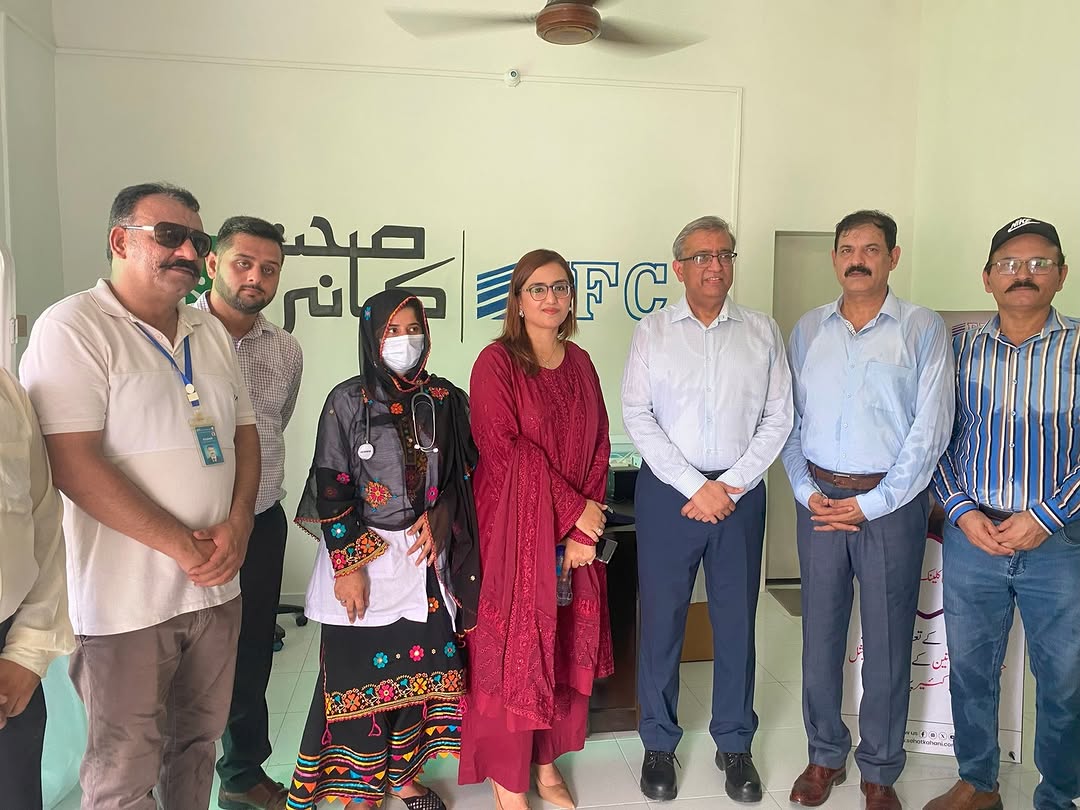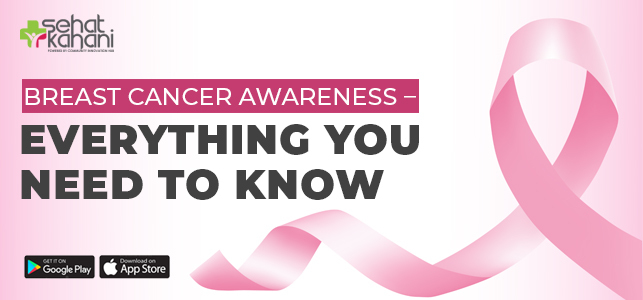
Introduction
Breast cancer is unfortunately a common disorder occurring in both men and women. However, the prevalence of breast cancer in women is higher. It is the most common type of invasive cancer in women and every one in nine women in Pakistan has the threat of getting diagnosed with it.
There is a significant lack of awareness around the topic of breast cancer, especially in Pakistan. Lack of awareness can be driven by a variety of reasons including the lacking or inaccessibility of information, cultural taboos, fear of accessing healthcare for a particular body part, lack of sexual education, fear of judgment, and general myths around the topic.
With Pakistan having the highest incidence rate of breast cancer in Asia, it is important to spread its awareness. This blog contains important and authentic chunks of information about breast cancer which will enlighten you about the disease, its symptoms, development, diagnosis, and treatment options.
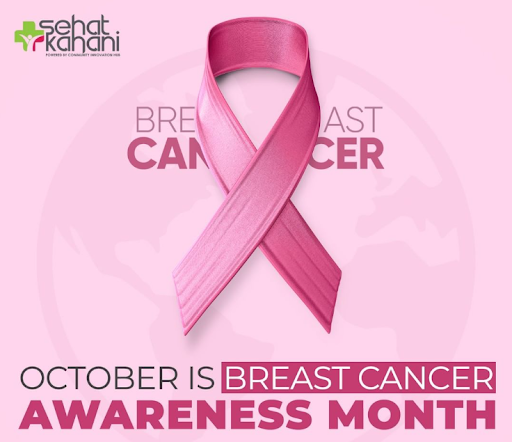
What is breast cancer?
Breast cancer is a disorder in which the breast cells divide in an uncontrollable manner. There are various types of breast cancer and the site at which cancer develops determines its type.
Different areas of the breast might give rise to breast cancer. Ducts, connective tissues, and lobules make up the structure of breasts. The glands that generate milk are called lobules which are transported through tubes known as ducts to the nipple. The connective tissue, which is made up of fatty and fibrous tissue, envelops and anchors all the structures at its place. The ducts or lobules are where most breast cancers start.
There are two majorly occurring types of breast cancer Invasive ductal and Invasive lobular carcinoma. Invasive cancers can spread to other parts of the body; this phenomenon is scientifically called metastasis of cancer and for metastasis, the usual route for breast cancer is blood and lymph vessels. Invasive ductal carcinoma starts in the ducts of the breasts and continues to grow to the other parts of the breast tissues. Whereas, Invasive lobular carcinoma starts from the lobules of the breasts and continues to grow in other parts of the breasts. The other less common types of breast cancer include inflammatory breast cancer, Paget’s disease, medullary breast cancer, and mucinous breast cancer.
Early signs of breast cancer
Awareness of the signs and symptoms of breast cancer is very important. It will help you in your self-examination which can ensure early detection. Common breast cancer symptoms include;
A lump
The most commonly known symptom of breast cancer is a lump in the breasts. These lumps persist and don’t go away with time. Lumps are usually detected by mammograms way before they are physically notable. These lumps don’t cause any breast pain. These are hard and irregular entities that can be distinguished from the other tissues. The skin covering this lump may appear dimpled or red.
Swelling in the armpit or near the collarbone
Any such bulges indicate invasive cancers. It shows that cancer has spread to the lymph nodes of the armpits. Again, in many instances, lumps are not noticeable to the patients due to their smaller size which is why you should keep an eye on such swellings as well and get immediate medical attention if you notice them.
Breast pain and tenderness
Lumps present in the breasts are usually painless. However, they may cause some prickly sensations.
Dents or flatness on the surface of breasts
Such dents or flat areas present on the surface of the breasts indicate undiagnosed tumors.
Changes in breasts
Smaller changes in breasts may also be indicating the presence of breast cancer in your body. The alterations to look for include changes in size, temperature, and even the texture of your breasts.
Changes in nipples
You should also keep a keen eye on the changes in your nipples. If you notice any sores, itches, burns, or dimpling in your nipples, it is time to seek medical attention. Clear, bloody, or any type of discharge from your nipples other than milk should also be taken seriously.
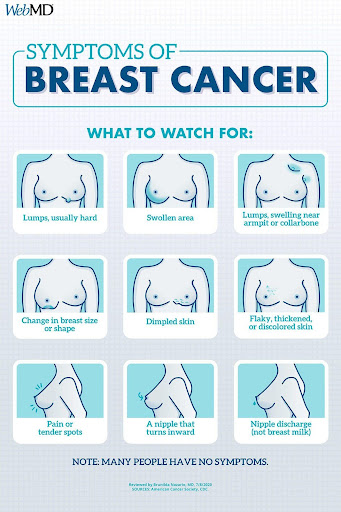
Causes of breast cancer
Following are the leading causes behind the development of breast cancer;
Age
With age, the risk of breast cancer intensifies. People above the age of 50 are more prone to breast cancer.
Genetics
Genetic mutations cause cells to divide in an uncontrolled manner leading to the development of cancers. BRCA1 and BRCA2 are the types of gene mutations that put women at a higher risk of breast and ovarian cancer.
Reproductive health
The time and onset of menstruation can also put women at higher risk of breast cancer. If you are someone who started having menstrual periods before the age of 12 and got your menopause after the age of 55, then you are at a higher risk of breast cancer. This is because the longer duration of menstruation exposes women to hormones longer, increasing their risk of breast cancer.
Denser breast tissues
Mammography is one of the main tests that doctors conduct to diagnose tumors in the breasts. When the tissues of the breast are dense, they contain more fat which makes it harder for doctors to detect tumors. This makes people with denser breasts more susceptible to breast cancer.
Medical history
Breast cancer, unfortunately, tend to reoccur which makes women with a previous history of cancer more at risk. Other non-cancer diseases which increase the risk of breast cancer include atypical hyperplasia or lobular carcinoma in situ. Breast cancer is more likely to develop in women during their lives if they received radiation therapy to the chest or breasts before the age of 30.
Family history
Having a first-degree relative who has had breast or ovarian cancer can increase your odds of getting breast cancer. First-degree relatives include the mother, sister, daughter, son, father, and brother.
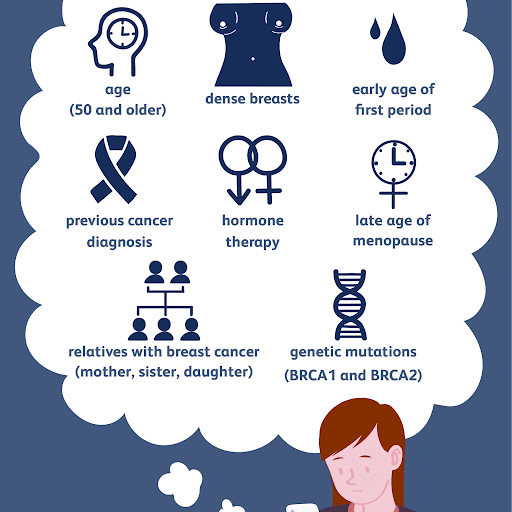
How is breast cancer diagnosed?
Numerous methods are used to diagnose breast cancer. The most popular methods are;
Breast exam
This exam is conducted physically by the doctor in which they look for lumps and other malfunctions in the breasts and lymph nodes of the armpits.
Mammogram
It is a test that uses low-dose X-rays on the breast to help find tumors. Mammograms help in the detection of tumors in the breast before they become large enough to cause symptoms. Early detection amplifies the odds of efficacious treatment of breast cancer. When a tumor is smaller and cannot yet be seen or felt, a mammogram is used to detect it.
Breast ultrasound
Ultrasound is a credible method that is used to image deep structures of the body. A breast cancer diagnosis can be used to differentiate between solid and fluid-filled lumps.
Biopsy
It is the method used in the diagnosis of breast cancer in which a tissue sample of breast is taken. It is the most credible and sure-shot way used for the diagnosis of breast cancer. In this test, the extracted sample is carefully analyzed. Your breast is marked with a tiny metal marker so that it can be easily found during subsequent imaging procedures.
Experts in a laboratory analyze biopsy samples to ascertain whether the cells are malignant. The type of cells involved in breast cancer, its grade, and whether the cancer cells have hormone receptors or other receptors that could affect your treatment options are all determined by analyzing a biopsy sample.
Breast Magnetic Resonance Imaging (MRI)
In this type of diagnostic test, both radio and magnetic waves are used to imaging the internal structure of the breasts. MRI differs from other imaging tests as it does not utilize radiations for the formation of images.
Treatment for breast cancer
There are a variety of treatment options available for breast cancer as there are various breast cancer stages and types. It is also dependent on how much cancer has spread. Cancer patients are usually treated with a customized blend of treatments.
Surgery
To get rid of the tumor, surgery is preferred. The surgeries that are performed for the treatment of breast cancer remove the tumor along with some surrounding healthy tissues. The two types of surgeries used for the treatment of breast cancer include lumpectomy and mastectomy. A lumpectomy is a surgery that is used to remove a tumor and some healthy tissues around it. Whereas mastectomy is the removal of the entire breast.
Chemotherapy
In chemotherapy, specific drugs are used to reduce or eradicate cancer cells. The medication can be given to the affected patients orally or intravenously, or occasionally both.
Biological therapy
Biological therapy collaborates with the immune system of your body to combat cancer cells or to manage the negative effects of other cancer treatments.
Radiation therapy
Breast cancer can be treated with radiation therapy almost at any stage. A great way to lower your risk of breast cancer coming back after surgery is with radiation therapy. Additionally, it is frequently utilized to reduce the symptoms brought on by cancer that has migrated to other body regions (metastatic breast cancer).
Hormone therapy
By inhibiting the body’s ability to manufacture hormones or by interfering with the effects of hormones on breast cancer cells, hormone therapy (also known as hormonal therapy, hormone treatment, or endocrine therapy) slows or stops the growth of hormone-sensitive tumors.
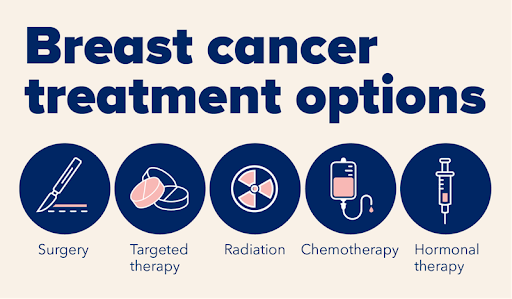
Why is it important to spread awareness?
For effective treatment, prevention, early identification, tailored therapy, awareness is crucial. People are more inclined to take preventative action and go for screenings, testing, and checkups if they are aware of a disease and its symptoms.
To enhance passion and support, inspire action, and mobilize local expertise and resources, it is critical to raise public awareness. Raising political awareness is crucial because politicians and policymakers play a crucial role in the process of adjusting policy. To get the desired result, good communication tactics are needed when raising awareness. A general term for the combination of these communication tactics is “awareness raising campaign,” which is intended for a specific audience over a specific period. The purpose of awareness-raising campaigns varies depending on the context, but it typically includes raising awareness, educating the intended audience, promoting a favorable image, and making an effort to influence their behavior.
Like every year, on the occasion of World Breast Cancer Month, Sehat Kahani is aiming to spread awareness out there to our readers. We have a variety of blogs and social media posts on the topic of breast cancer which can help you increase your self-awareness.
Conclusion
The prevalence of breast cancer is very high. Upon early detection of breast cancer when it is in the localized stage, the 5-year relative survival rate is 99%. This is why people need to have basic awareness about the disease, its symptoms, causes, diagnosis, and treatment. This blog has educated you about all five of these factors. For more information on breast cancer, visit our other blogs.


